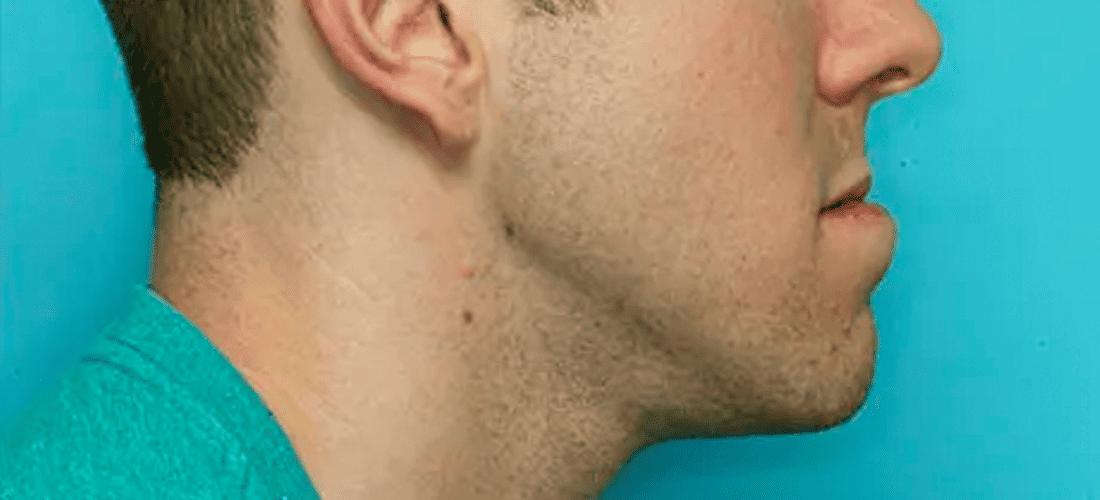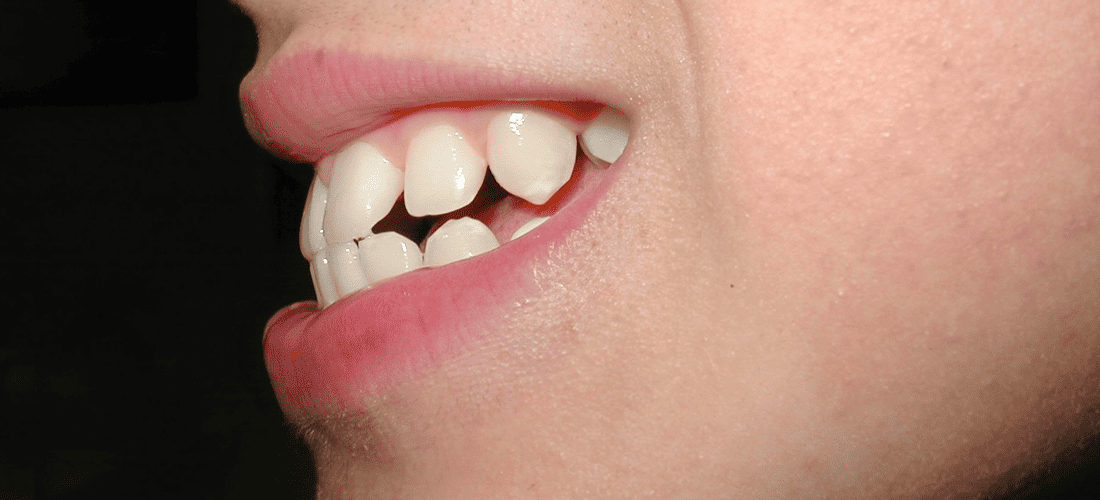
Having an underbite impacts your oral health in significant ways. From difficulty in chewing to speech impediments, this dental alignment problem is often corrected through invasive means like braces or surgery. However, it’s entirely possible to correct an underbite naturally, right in the comfort of your home.
This article presents six effective, natural solutions to address the problem of underbite and other related dental issues. All of them can be also found on the Mewing.coach app. It is packed with a wide range of mewing exercises, timely reminders, and invaluable tips. If you want to fix underbite naturally, this is the way to go.
Start with a quiz below!
What Is An Underbite?

An underbite, also known as Class III malocclusion, occurs when the lower teeth sit more forward than the upper teeth. This dental misalignment results from the jaws not fitting together as they should. The severity of an underbite varies and is easiest to define visually.
In minor cases, the malocclusion may not even be noticeable to casual observers. However, severe underbite cases present with a lower jaw visibly protruding outward, extending beyond the upper jaw. The more underbite is visible, the more severe the complications.
When your lower jaw sits forward, the underbite imbalance results in strain on the jaw muscles. This leads to discomfort and, over time, chronic jaw pain. Another issue is mouth breathing. An underbite often makes it challenging to close the mouth fully, resulting in a reliance on breathing through the mouth.
This habit has its own set of complications, such as a dry mouth and a higher risk of oral infections. One other underbite complication associated with mouth breathing is sleep apnea. The misalignment can obstruct airways during sleep, leading to breathing interruptions. It causes poor sleep quality and can have long-term health implications, including cardiovascular issues.
Speech impediments also commonly occur in those with severe underbite. The unusual positioning of the jaw and teeth affects the clarity of speech, making it difficult to pronounce certain words or sounds. This underbite complication usually appears in childhood.
How Do Underbites Develop?

Underbites often develop due to a mix of factors, one of which is genetics. If another family member suffers from an underbite, it’s likely that the condition is hereditary. Luckily, in this case, patients can start to fix an underbite quite early.
Physical injuries to the upper teeth or jaw can also cause an underbite. Specifically, a broken jaw that doesn’t heal properly post-surgery may result in jaw misalignment similar to an underbite. That’s why it’s important to regularly visit a dentist if you had jaw surgery. Fully developed underbites can later be much harder to fix.
Childhood habits like mouth breathing, as well as excessive thumb sucking, pacifier use, and bottle feeding, can alter the shape of a developing jaw. For instance, extensive thumb-sucking draws the lower jaw forward while pushing the upper jaw backward, contributing to an underbite.
Lastly, tumors or cysts in the jaw area can cause an underbite by displacing or destroying surrounding tissue. Such tissue is crucial for supporting the jaw. If this tissue is damaged and doesn’t heal well, it might lead patients to an underbite as it becomes harder to keep the jaw in the proper place.
Why You Should Fix an Underbite?
Addressing an underbite is crucial not only for aesthetic reasons but also for oral and general health. Left untreated, underbites can make daily activities like chewing and speaking difficult. These misalignments can induce jaw pain, foster mouth breathing, lead to sleep apnea, and create speech impediments.
Another important aspect is that the longer a patient does not correct his underbite, the harder it will be to correct it later. For example, bite correction early in childhood is the most effective as the jaw and its misalignments, such as an underbite, are not fully developed yet. Underbite treatment for adults or the elderly is more complicated and may even require surgery.
It’s also important to highlight that some specific types of underbites, such as a skeletal underbite, are usually genetic, and there is no way to prevent their complications. Such underbite cases must be treated in early childhood. If a patient neglects early treatment, surgical means might be necessary later.
To correct an underbite is not just about improving your looks – it’s about enhancing your quality of life. But how exactly can you fix this problem naturally?
How To Fix Underbite Naturally? Six Solutions
Underbite Correction Exercises
Natural exercises offer promising possibilities for correcting underbites without invasive procedures. These treatment exercises aim to promote proper jaw development and alignment.
There are many exercises that patients can find online. However, I found only three of them to be actually effective. Although they are not instant fixes, these treatment exercises contribute to better jaw alignment and improved overall oral health.
Tongue Thrust Exercise
- Sit in a relaxed position with your shoulders back.
- Place the tip of your tongue behind your upper front teeth.
- Press your tongue against the roof of your mouth.
- Hold this position for 5 seconds and release.
- Repeat 10 times.
The tongue thrust primarily strengthens the tongue and promotes better positioning, which encourages proper jaw alignment. While easy to perform and accessible, it’s more of a preventive measure and may take time to show tangible results when you want to correct your underbite.
Chin Tuck Exercise
- Stand or sit up straight.
- Keep your chin parallel to the ground.
- Without tilting your head, pull your chin and head straight back.
- Hold for 5 seconds and release.
- Repeat 10 times.
The chin tuck exercise excels in correcting forward head posture, which in turn promotes better upper jaw alignment. Also, Chin Tuck is one of the best ways to achieve proper tongue position as it helps to naturally curve your tongue to the upper palate. Because of the same reason, mewing helps to fix an underbite.
Jaw Opening Exercise
- Sit or stand up straight.
- Open your mouth as wide as comfortably possible.
- Hold the position for 5 seconds.
- Close your mouth gently.
- Repeat 10 times.
For the jaw opening exercise, the direct focus on lower jaw muscles enhances their strength and flexibility. Despite its benefits, executing the exercise too aggressively could lead to discomfort or exacerbate existing lower jaw pain. Be cautious and don’t try to progress too fast with this straightening exercise.
Correcting Underbite With Proper Tongue Posture and Oral Habits
The position of your tongue during rest has a significant influence on your jaw’s alignment and overall oral health. Proper tongue posture entails placing the tongue against the roof of your mouth rather than letting it sit at the bottom. This positioning maintains the jaw’s natural alignment and can contribute to correcting an underbite over time.
The significance of tongue position during rest lies in its ability to keep your jaw in its natural place. This, in turn, helps prevent worsening of an underbite and could gradually correct minor malocclusions. A mispositioned tongue, on the other hand, may push your lower jaw forward, thereby exacerbating an existing underbite.
Besides tongue posture, several other oral and dental habits can impact the treatment of your underbite. Mouth breathing, for instance, can change your jaw’s shape over time. Teeth grinding, known as bruxism, can wear down your teeth, further affecting alignment. Chewing predominantly on one side of the mouth can also result in imbalanced jaw muscles, making the underbite more pronounced.
To maintain proper tongue posture, make it a habit to perform tongue exercises regularly. You can also set reminders throughout the day to check your tongue’s position. In breaking harmful habits, awareness is key.
Breathing and Sleep Position For Fixing Underbite
Breathing patterns and sleep positions are intrinsically tied to the health of your face, jaw, and the alignment of your teeth. Specifically, the way you breathe and position yourself during sleep can either mitigate or exacerbate an existing underbite.
Nasal breathing is more beneficial for oral health because it maintains the natural position of the tongue against the roof of the mouth. This helps preserve and correct proper jaw alignment, reduces teeth grinding, and lessens the risk of developing or worsening an underbite. So the difference between mouth breather and nose breather is that the latter has less chance of underbite issues and provides more oxygen.
As for sleep positions, back sleeping is the most advisable for those trying to correct underbites as it allows the jaw to rest in a neutral position. Side sleeping can sometimes cause an imbalance in jaw muscles, leading to an underbite over time. Stomach sleeping should be avoided altogether as it places undue stress on the face, and jaw and can lead to significant misalignment issues.
To optimize your sleep position and breathing for underbite correction, start by consciously adopting nasal breathing during the day. This practice will gradually translate to your sleep. Experiment with pillows and sleep aids to maintain a good sleeping position. If you are a mouth breather during sleep, consider the use of adhesive strips to encourage nasal breathing.
Fixing Underbite Naturally With Diet and Nutrition
Your dietary choices can have a lasting impact on the development of your face, jaw, and dental structure, preventing or resulting in an underbite problem. Foods rich in vitamins and minerals, particularly calcium and vitamin D, are essential for proper jaw growth and oral health. With the correct amount of minerals and vitamins, jaw and dental structure might not develop or deteriorate over time.
Crunchy fruits and vegetables like apples and carrots, as well as dairy products, provide essential nutrients while also giving your jaw and teeth a good workout. This helps in maintaining a strong upper jaw, alleviating the severity of an underbite, or even fixing it to an extent over a long period of time.
Of course, not all crunchy foods are good as a treatment. Foods and beverages high in sugar can actually deteriorate your teeth. That’s why most mewing gums do not have any added sugar or preservatives.
While it cannot replace professional teeth and jaw treatment, such as braces or surgery, food choice can be a good preventive treatment. There is a correlation between children who do not eat a well-balanced diet and have an underbite. To a lesser extent, the same applies to adults, but their teeth and face are already developed.
Seeking Professional Help To Fix Severe Underbite
While natural remedies can prove effective when you want to correct mild underbites, a severe problem often requires professional intervention. Consultation with orthodontists or oral health professionals is essential for proper diagnosis and a plan to correct an underbite.
An orthodontics treatment like braces, aligners, and lower or upper jaw expanders is often necessary for severe underbites. I recommend using the best night guard for teeth grinding to my patients as it can help with grinding their teeth during sleep.
These treatments are especially effective when combined with other holistic approaches as they all are non-surgical options for the treatment of your underbite. Being non-invasive, they don’t have any major side effects on teeth or the jaw and cost only a little.
In extreme cases, teeth or jaw surgery may be recommended by dental professionals for an adult with an underbite. While it is the most effective treatment, the problem with surgery or related approaches is that they are expensive and can have lasting side effects. It’s best to first find all the natural ways of how to fix an underbite and then consider surgery.
Early Intervention for Children With Underbite
Identifying and treating an underbite early, especially in children, is crucial for effective problem management. Early intervention can prevent severe cases and offers a greater range of treatment options, many of which are more effective when the jaw is still developing. It is quite common for children to wear braces, clear aligners, or other methods that crooked teeth treatment require.
Unfortunately, many parents still view any similar treatment of an underbite with skepticism. However, they should consider evaluations of an orthodontics professional for their children before seven. At this age, the teeth and jaw are not fully developed yet, so it’s easier to find a method that works and is not surgical. It can both improve the dental health of the children and save money.
Natural Underbite Treatment: Conclusion
Incorporating these non-surgical underbite treatment techniques into a holistic therapy can help you to correct underbite naturally. Mewing stands out for its comprehensive benefits, and our Mewing.coach app provides an array of exercises, reminders, and tips to guide you through this process. The extra effort spent on mewing is well worth the benefits it delivers in correcting your underbite or other dental problems.



